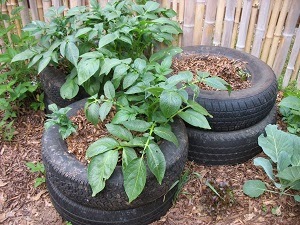Here’s a question that I get from potato lovers: “How can I grow potatoes in abundance in limited space?”
Growing potatoes in tires can be quite simple and here are my instructions how to do it and have a bumper crop. You get a chance to do some recycling and vertical gardening all together.
Depending on the size of the tires, I first wash them. If they are small enough for me to get them in my pickup truck, I’ll take them to a car wash and wash them under pressure
with soap then rinse with water. Inside the tire and outside as well, making sure the tread is free from road grim and grit.
with soap then rinse with water. Inside the tire and outside as well, making sure the tread is free from road grim and grit.
You’ll want to set the tire away from an prevailing winds to keep their foliage from getting wind damage. Make sure the spot you select will be free of most foot traffic and out
of the way of activities to avoid the set-up from being knocked over. Press down any growth on the ground such as clover or grass, and lay a thick mat of saturated newspapers over the grass or area which you will be setting tire over. Over this, put down 2 nice layers of cardboard: one long ways, the other cross ways: you can cut the cardboard away AFTER you position the tires on top of the cardboard. The newspaper will soon deteriorate into the soil, but the cardboard hangs around for awhile, giving added protection against weeds and grass that would come up into the tire.
of the way of activities to avoid the set-up from being knocked over. Press down any growth on the ground such as clover or grass, and lay a thick mat of saturated newspapers over the grass or area which you will be setting tire over. Over this, put down 2 nice layers of cardboard: one long ways, the other cross ways: you can cut the cardboard away AFTER you position the tires on top of the cardboard. The newspaper will soon deteriorate into the soil, but the cardboard hangs around for awhile, giving added protection against weeds and grass that would come up into the tire.
Whether or not you trim away the rim of the top tire is your decision. Some tires I do trim, others I do not. The bigger the tire is, the more likely I am to trim away the
sidewall up to its tread. (This is just my own way of doing things).
sidewall up to its tread. (This is just my own way of doing things).
Wet the cardboard down really good then start stuffing newspapers, leaves, straw, corncobs, sawdust or whatever you have that will absorb moisture into the inner rim
of the tires so when rains come, the organic material will take up the excess moisture and hold it till the plants need it the most: moisture will “wick” away from the inner rim into the main tire container area.
of the tires so when rains come, the organic material will take up the excess moisture and hold it till the plants need it the most: moisture will “wick” away from the inner rim into the main tire container area.
Once your potatoes are in place, dusted with wood ash, cover with a layer (not pressed down) of straw, shredded newspapers, compost, or whatever mulch you’ll be using, then cover the top hole with a piece of glass, Plexiglas, or you can rig clear plastic over the top if you have nothing else to use. Glass and/or Plexiglas is ever so much easier on you the gardener, than using the plastic cover is. Because the bed must be watered weekly unless rainfall measures 1-inch. You never want the soil to dry out, and potatoes (sweet and Irish) need a lot of water to return you a bumper crop.
Irish potatoes need only 4-inches of top growth. When your tater vines/plants reach 6-inches tall, it’s time to add a 2-inch layer of mulch, and snug it up around the potato plant stems. When it’s time, add another tire on top of the first one. And just keep adding mulch, water, and tires until the stack grows 5-6 tires tall. You may need to drive a wooden stay on 2 or 3 sides of the tires so they won’t blow over when storms come, or when you brush against them, or dogs hit them while chasing a ball, or once night temps no longer offer a chance of frost, you can omit the glass top: if you have who might eat the tater vine, you can use an old window screen instead of the glass top. And when the temps get around or above 80 degrees, put a layer of newspaper around the upper edge of the top most tire: this will to deflect heat away from the tire and preserves inner moisture as well.
The first blooms that form, I pinch off. This pours more growth to the roots which is what you’ll harvest anyhow. The 2nd set of blooms, I allow to form and soon after the vines will begin to dry and become mulch. You can “dig” your taters by removing one tire at a time. If you’ll prepare another tire spot before unloading your tater tire, as soon as you remove one tire, you can roll it over on top of the cardboard spot you’ve just made beside your tater tire, and by the time your potatoes are all lying out on the ground, you’ll have another tater tower built ready to plant into again to make another crop of late fall taters to harvest just before a hard freeze hits your area…depending, of course, on just what area that is.

No comments:
Post a Comment